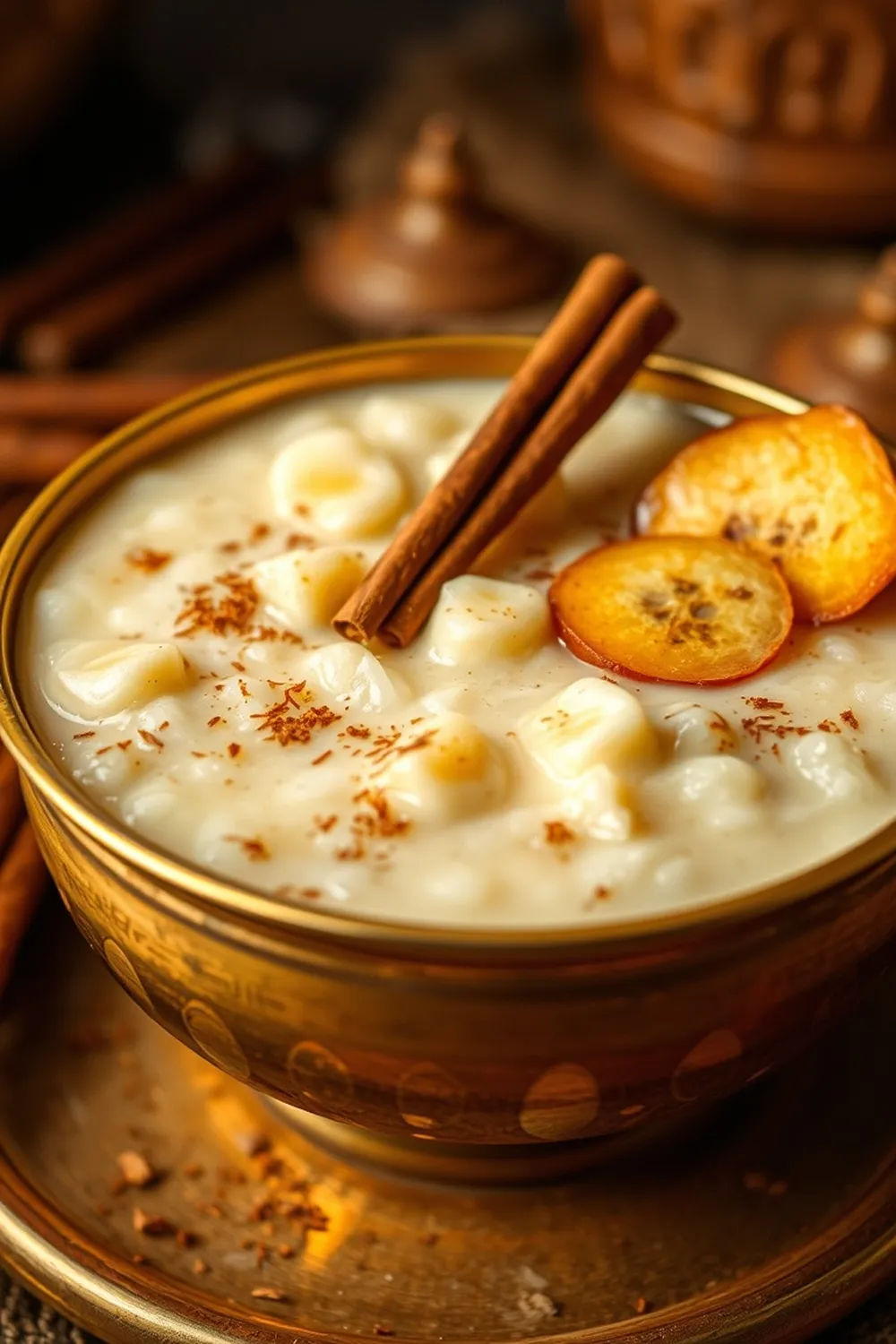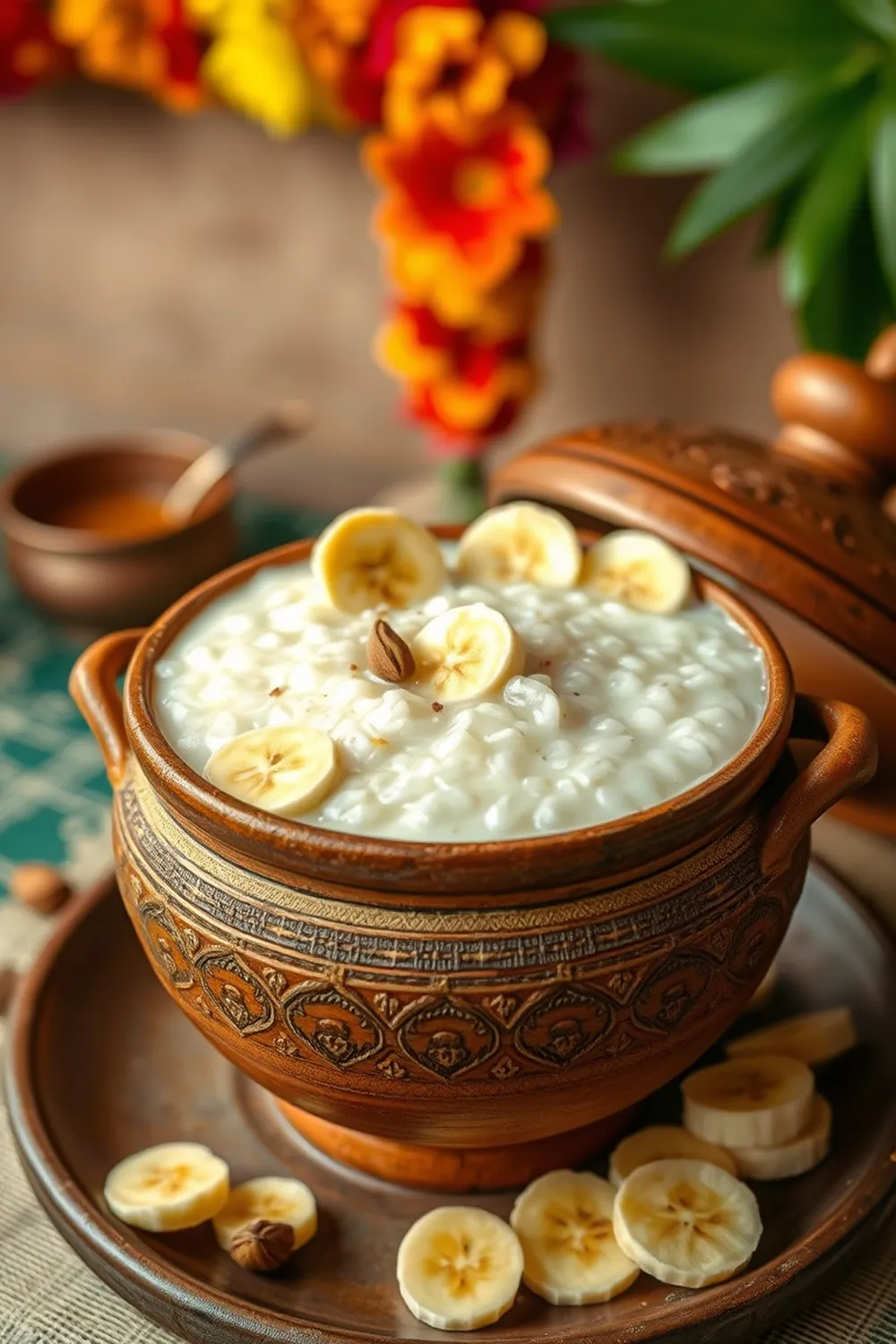- Grind the soaked rice and grated coconut into a coarse mixture using a blender or food processor.
- In a pot, combine water, jaggery, cinnamon sticks, and cardamom powder. Bring to a boil until the jaggery is completely dissolved.
- Add the rice-coconut mixture, salt, and chopped plantain to the pot. Stir well to combine.
- Cook on medium heat for 15-20 minutes, stirring frequently, until the payasam thickens.
- Adjust sweetness and salt levels to taste. Add warm water to adjust the consistency if needed.
- Serve warm, garnished with cinnamon. If stored, reheat gently with a little water before serving.
- Calories:250 kcal25%
- Energy:1046 kJ22%
- Protein:3 g28%
- Carbohydrates:55 mg40%
- Sugar:30 mg8%
- Salt:300 g25%
- Fat:5 g20%
Last Updated on 6 months ago by Neha Deshmukh
Plantain Rice Payasam Recipe – Authentic Kerala Sweet Recipe
Hey everyone! Today, I’m sharing a recipe that’s incredibly close to my heart – Plantain Rice Payasam. This isn’t just a dessert; it’s a warm hug in a bowl, a taste of my childhood, and a staple in every Kerala household, especially during festivals. I remember my grandmother making this every Onam, and the aroma would fill the entire house! It’s surprisingly easy to make, and I promise, the results are so worth it.
Why You’ll Love This Recipe
This Plantain Rice Payasam is more than just sweet and delicious. It’s comforting, subtly spiced, and has a beautiful texture. The plantain adds a unique sweetness and creaminess you won’t find in other payasams. Plus, it’s a relatively quick dessert to whip up, perfect for when you want something special without spending hours in the kitchen. It’s a guaranteed crowd-pleaser!
Ingredients
Here’s what you’ll need to make this Kerala classic:
- 0.5 cup rice
- 0.25 whole coconut
- 500 ml water
- 200 gm jaggery
- 2 cinnamon sticks
- 0.5 tsp cardamom powder
- 1 tsp salt
- 1 large ripe plantain
Ingredient Notes
Let’s talk ingredients! Getting these right makes all the difference.
- Kerala Jaggery: If you can get your hands on Kerala jaggery (vellam), do it. It has a unique, smoky flavour that really elevates the payasam. If not, any good quality jaggery will work, but try to find one that’s dark and unrefined.
- Rice Varieties: Traditionally, pachari rice or kavuni rice are used for payasam in Kerala. These varieties give a lovely creamy texture. However, any short-grain rice like Sona Masoori will work well too.
- Coconut: Freshly grated coconut is best! It adds a wonderful aroma and flavour. Avoid using desiccated coconut if possible, but if you must, use a good quality one and soak it in a little warm water before using.
- Plantain: The plantain (ethakka) is a star in Kerala cuisine. It needs to be perfectly ripe – almost bordering on overripe – for the best sweetness and texture. Look for plantains that are mostly black with a few yellow patches.
Step-By-Step Instructions
Alright, let’s get cooking!
- First, grind the soaked rice and grated coconut into a coarse mixture using a blender. Don’t add too much water – you want a slightly grainy texture.
- In a pot, combine the water, jaggery, cinnamon sticks, and cardamom powder. Bring this to a boil, stirring until the jaggery is completely dissolved. This is important, or you’ll end up with grainy payasam!
- Now, add the rice-coconut mixture, salt, and chopped plantain to the pot. Give it a good stir to combine everything.
- Cook on medium heat for about 5 minutes, stirring occasionally. You’ll notice the payasam starting to thicken. Keep stirring to prevent it from sticking to the bottom.
- Taste and adjust the sweetness and salt levels as per your preference. If it’s too thick, add a little warm water to adjust the consistency.
- Finally, serve warm, garnished with a cinnamon stick. If you’re storing it, it will thicken as it cools, so just reheat it with a splash of water before serving.
Expert Tips
- Don’t overcook the plantain: You want it to soften and blend into the payasam, but not disintegrate completely.
- Stir, stir, stir! Seriously, constant stirring is key to preventing sticking and ensuring a smooth texture.
- Jaggery consistency: If your jaggery is very hard, you can gently warm it up slightly to make it easier to dissolve.
Variations
Want to switch things up? Here are a few ideas:
- Vegan Adaptation: Use plant-based milk (coconut milk works beautifully!) and substitute the jaggery with maple syrup or coconut sugar.
- Gluten-Free: This recipe is naturally gluten-free!
- Spice Level: If you love cardamom, feel free to add a little more. A pinch of nutmeg also works wonders.
- Festival Adaptations: During Onam or Vishnu festivals, some families add a few strands of saffron for a richer flavour and colour. My aunt always adds a tiny bit of ghee for extra richness!
Serving Suggestions
Plantain Rice Payasam is best served warm. It’s delicious on its own, but you can also pair it with a side of papadum or a simple banana slice. It’s the perfect ending to a traditional Kerala meal.
Storage Instructions
Leftover payasam can be stored in an airtight container in the refrigerator for up to 3 days. It will thicken as it cools, so just add a splash of water or milk when reheating.
FAQs
Let’s answer some common questions:
- What type of rice is best for Payasam? Traditionally, pachari or kavuni rice are used, but Sona Masoori works well too.
- Can I use coconut milk instead of grated coconut? Yes, you can! Use about 200ml of thick coconut milk. The flavour will be slightly different, but still delicious.
- How do I adjust the sweetness of the Payasam? Add more jaggery (or your chosen sweetener) a little at a time, tasting as you go.
- What is the role of plantain in this recipe? The plantain adds a unique sweetness, creaminess, and a lovely texture to the payasam.
- Can this Payasam be made ahead of time? Yes, you can make it a day ahead. Just reheat it gently with a little water or milk before serving.
Enjoy making this delicious and authentic Kerala treat! I hope it brings as much joy to your table as it does to mine. Let me know how it turns out in the comments below!
Neha Deshmukh
Neha holds a B.A. in History with a focus on Indian and world history, including ancient, medieval, and modern periods. At RecipesOfIndia.org — the world’s largest database of Indian recipes — she combines her love for food and history by exploring how India’s past has shaped its culinary traditions.









